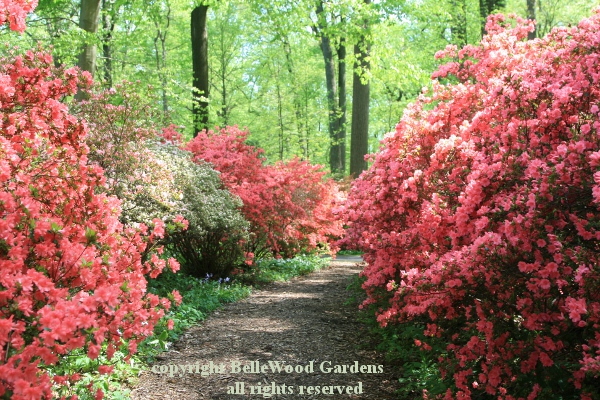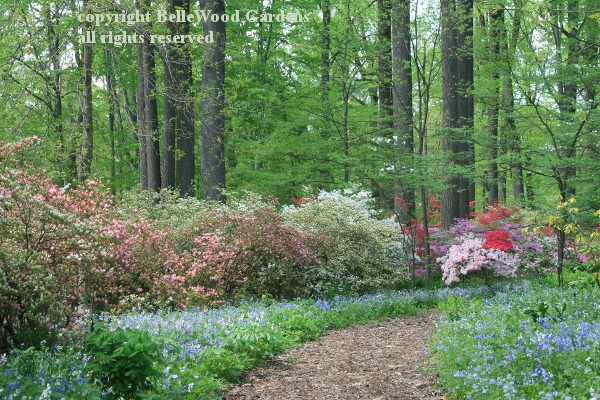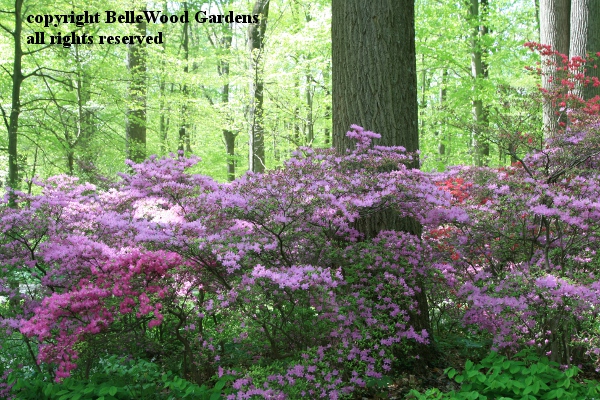
.
If you have any comments, observations, or questions about what you read here, remember you can always Contact Me
All content included on this site such as text, graphics and images is protected by U.S and international copyright law.
The compilation of all content on this site is the exclusive property of the site copyright holder.
Friday, 28 April 2017
It's the last Friday in April and feels warm enough for August. Forty-five Garden Writers Association members (from as far afield Georgia and Tennessee - they probably think the weather is fine) have registered for the Region II DuPont Triple Play event. We're going to Nemours, Mt Cuba Center, and Winterthur in Delaware, three estates of DuPont families now open to the public.
Winterthur is renown for its museum and gardens. It is a place that especially appeals to me, my fascination with bulbs finds much to appreciate.

A picture I took of the March Bank, back in 1995. Beneath the stately trees
the sloping ground is carpeted in blue from thousands of Scilla sibirica and
Chionodoxa species. Plant with a lavish hand and patiently give them time.
Today, however, it is almost May. The season is moving forward. Walking and talking, our group also moves forward. This has to be the ideal time to visit the Azalea Wood, where where Kurume hybrid azaleas, torch azaleas, and various other rhododendron species and cultivars are flowering in abundance.

Kurume hybrid azaleas are a large group of evergreen azaleas, originating near the Japanese city of Kurume. They became widely known in the West through the work and writing of E.H. Wilson. He selected and imported 50 cultivars from Japan, which arrived at Arnold Arboretum in Boston in 1919. Torch azaleas, derived in part from Rhododendron kaempferi, were developed in Holland after World War I.

The azaleas thrive in the woodland conditions.

Occasional benches offer an inviting place
to sit, relax, unwind, perhaps meditate.

Somehow Mae cleverly coordinated
her outfit with this azalea's flowers.

Flower colors are primarily in shades of pink to coral and red.

Underneath their flower ladden branches are assorted shade loving perennials
such as Trillium grandiflorum and Spanish bluebells, Hyacinthoides hispanica.

There are some outliers, like this sunny yellow Rhododendron luteum.

Or a drift of azaleas with soft lilac hued flowers. I do like it that
all the azaleas are left in their loose and open habit of growth,
and not pruned into the tight meatballs of foundation plantings.

Of course the real lilac hued flowers are those of lilacs. Fragrant too.
.
From here, we go into the Enchanted Woods, a fairy tale landscape for all children, even those older in years but young at heart. Mature oak trees create the canopy layer beneath which the woodland fairies have made a mystical, magical place just waiting to be discovered.
.

Quercus is the guardian of the trees in Enchanted Woods. He's an elf friend of the fairies, and lives high in the branches of an oak. He made Tulip Tree House from a giant tulip-poplar that lived for more than 100 years before it died of old age. With its lopsided thatched roof, it reminds me of the Hogwart's sorting hat.

Nearby is Faerie Cottage. Faerie, from Old French, includes all the woodland fae - fairies, pixies, nixies, elves and brownies, tree sprites, sylphs, and gnomes. Together, they all discovered a crumbling stone building with one wall falling down. It looks good from this side but the opposite wall, well, the opposite wall is missing.

And there's the Acorn Tea Room, a ring of columns with walls of air. I would like scones, with strawberry jam and clotted cream, to have with my tea.

A ring of magic. It's the Forbidden Fairy Ring, a circle of mushrooms left by the fairies when they danced at night under the moon. Never, ever step inside a fairy ring for if you do, you might disappear into the fairy land. Someone stepped in but fortunately it is daylight, not moonlight. Mist shimmers forth but they were able to get away.

We walk back into the "real" world, where our group of garden writers is refreshed with cookies and something to drink. Sitting in the shade under the tall trees, admiring the green world so admired and beloved by Henry Francis du Pont, and now enjoyed by the many visitors. What a wonderful time we've had on this, the Garden Writers Region II DuPont Triple Play.
Back to April 2017
Back to the main Diary Page